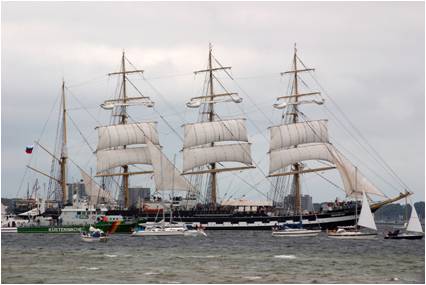I have long been impressed by the accomplishments of the old-fashioned sailing ships. I have even blogged about sailing ships in international shipping. Here. They raced to deliver goods at competitive speeds. They moved cargo from one side of the world to another. Sailing ships were THE fastest, best way to move anything – be it people or goods – for thousands of years.
What can I say? I am a fan. Then steam power was invented and later fossil fuel burning engines were applied to the shipping industry. The expertise needed to coax speed and efficiency out of canvas, rigging, and masts was replaced by concerns about fuel storage and efficiency. The great age of sail ended and cargo ships developed into low-lying hulks, bereft of grace and no longer powered by that mercurial but inexhaustible form of energy, the wind.
I know I know, I am romanticizing the golden age of sail. People got stuck for weeks, right, when capricious winds failed to materialize? Wind was just too unreliable an energy source. You couldn’t bank on it. Burning fossil fuels was “progress” and canvas couldn’t compete, otherwise it would have.
 But now, while we as a global community search for ways to lessen our impact on the planet, especially by reducing fossil fuel emissions, wind-power is attractive again. Scientists and engineers want to re-apply this low-impact technology to the problems of the international shipping industry.
But now, while we as a global community search for ways to lessen our impact on the planet, especially by reducing fossil fuel emissions, wind-power is attractive again. Scientists and engineers want to re-apply this low-impact technology to the problems of the international shipping industry.
In the world of international shipping, there are some serious current concerns. Big ones. Like how will we meet ever increasing clean-burning fuel legislation requirements? How can we reduce our operating costs? How can we use less fuel without sacrificing efficient shipping times?
One of the solutions offered is a return to using wind power to transport cargo internationally, reports the New Yorker. Nautical engineers have been tinkering with using sails to power commercial ships since at the 1980s.[1] The Carib Alba for example, a 3,500 ton merchant vessel, uses an “auxiliary wind propulsion” system.[2]According to their website, the Carib Alba design has proved cost effective and therefore “economically viable”.[3]
Recently however, other wind-powered commercial ship designs are being tested through the construction of prototypes. At least one of these prototype vessels, the B9, combines sails with a bio-gas engine to power the ship.[4] The result is an interesting hybrid of wind and bio fuel capable of powering a cargo ship on the high seas.
The B9 is intended to operate without fossil fuels. Its massive sails are 180 feet tall and affixed to 3 masts designed to make the 3,000 ton cargo carrier they are attached to economically viable as a fossil fuel–free commercial carrier on “certain trading routes”.
Herein lies the real challenge – to design a ship that is economical to operate and that includes sails as an integral feature. None of the latest ship designs are solely wind powered – instead wind power is used to supplement other forms of propulsion.
Engineers admit that reintroducing sail power isn’t appropriate for the largest commercial ships, but is viable for smaller craft. Ships in the 3,000-10,000 ton range could benefit from reintroducing sail-power, and ships of this size make up one fifth of the global commercial fleet.
The sails themselves are perhaps the most re-designed feature of all. One Japanese prototype featured massive aluminum and plastic sails attached to 164 feet masts. The sail themselves “are hollow” and are “designed to telescope into one another in rough weather.” [5] Such technology doesn’t sound pretty but sure sounds interesting!
The New York Times article points out an important fact, that while fuel costs account for the majority of shipping costs, cargo ship owners don’t pay for fuel – charterers do. This means that ship owners do not have the biggest incentive to invest in alternative energy sources for cargo ships.
This dynamic has produced a relatively “conservative” stance by ship owners when it comes to innovations in fuel efficiency. Fuel costs are related, but not directly, to ship purchase and commission decisions.
It seems that the return-to-sail is still in the experimental stages but considering the incentive – free renewable energy – it seems worth it in the long run to invest in trying to make it work.
What do you think? Can wind power be applied to commercial cargo vessels in an economically viable way? Comment below.
